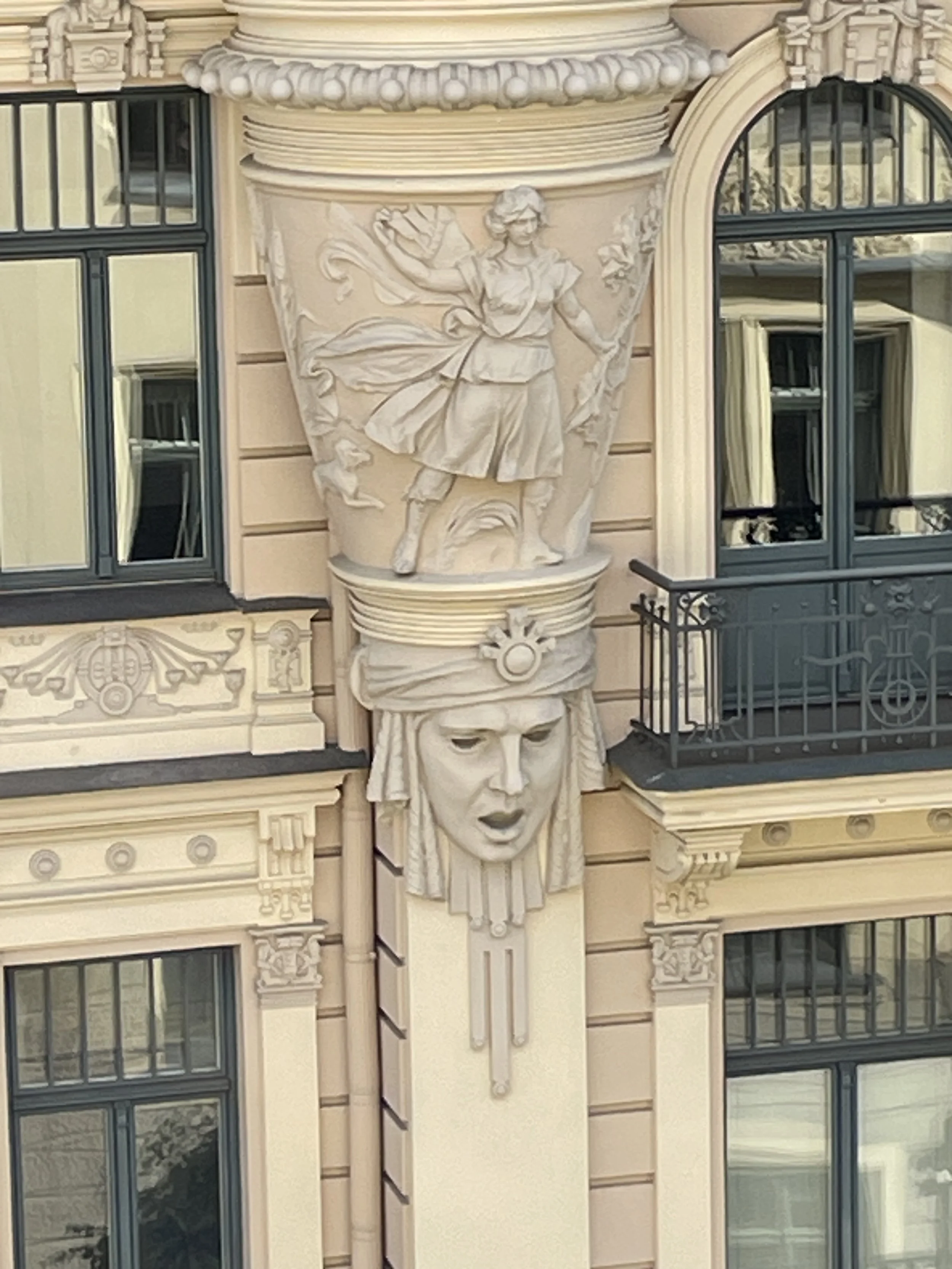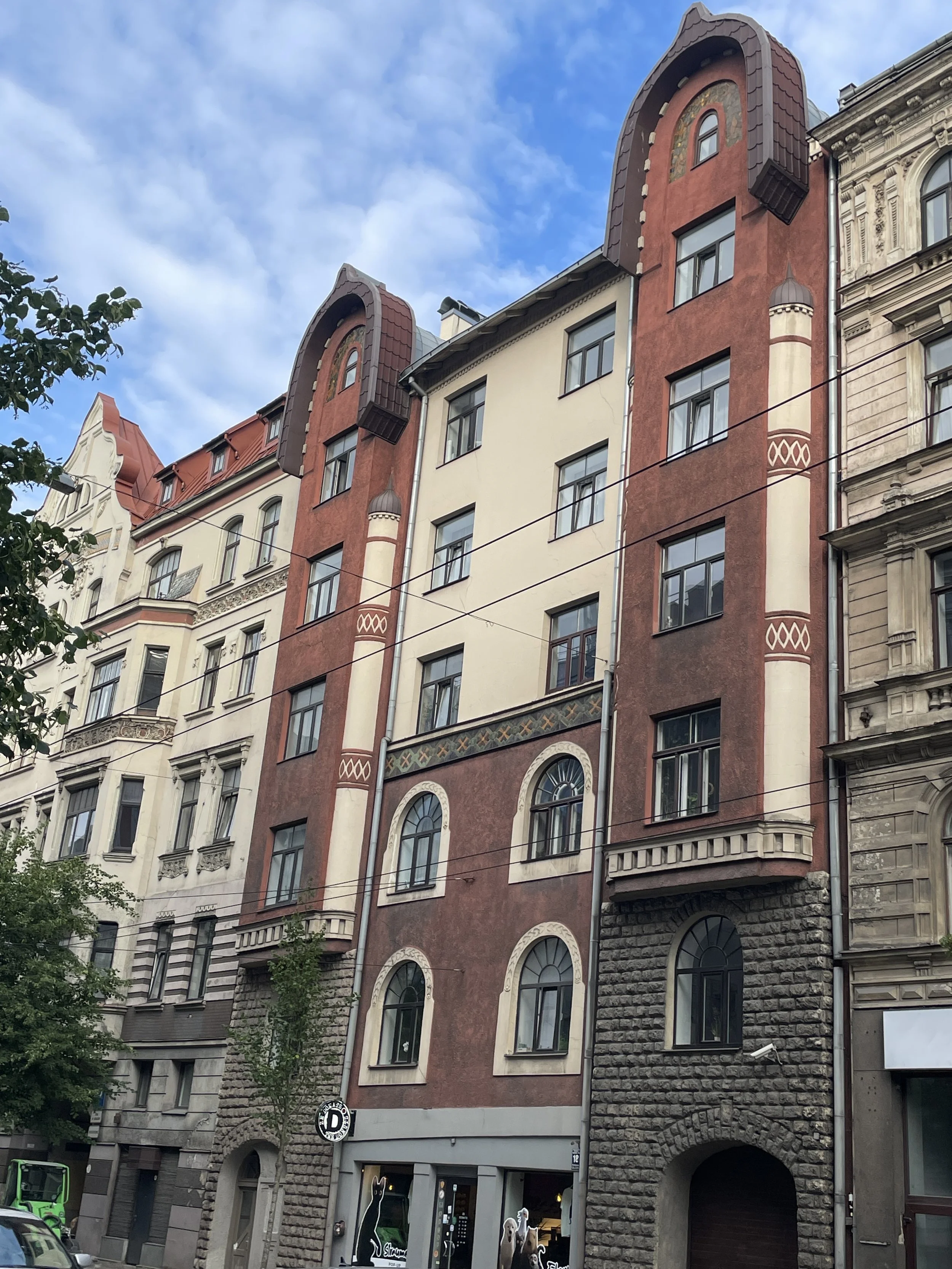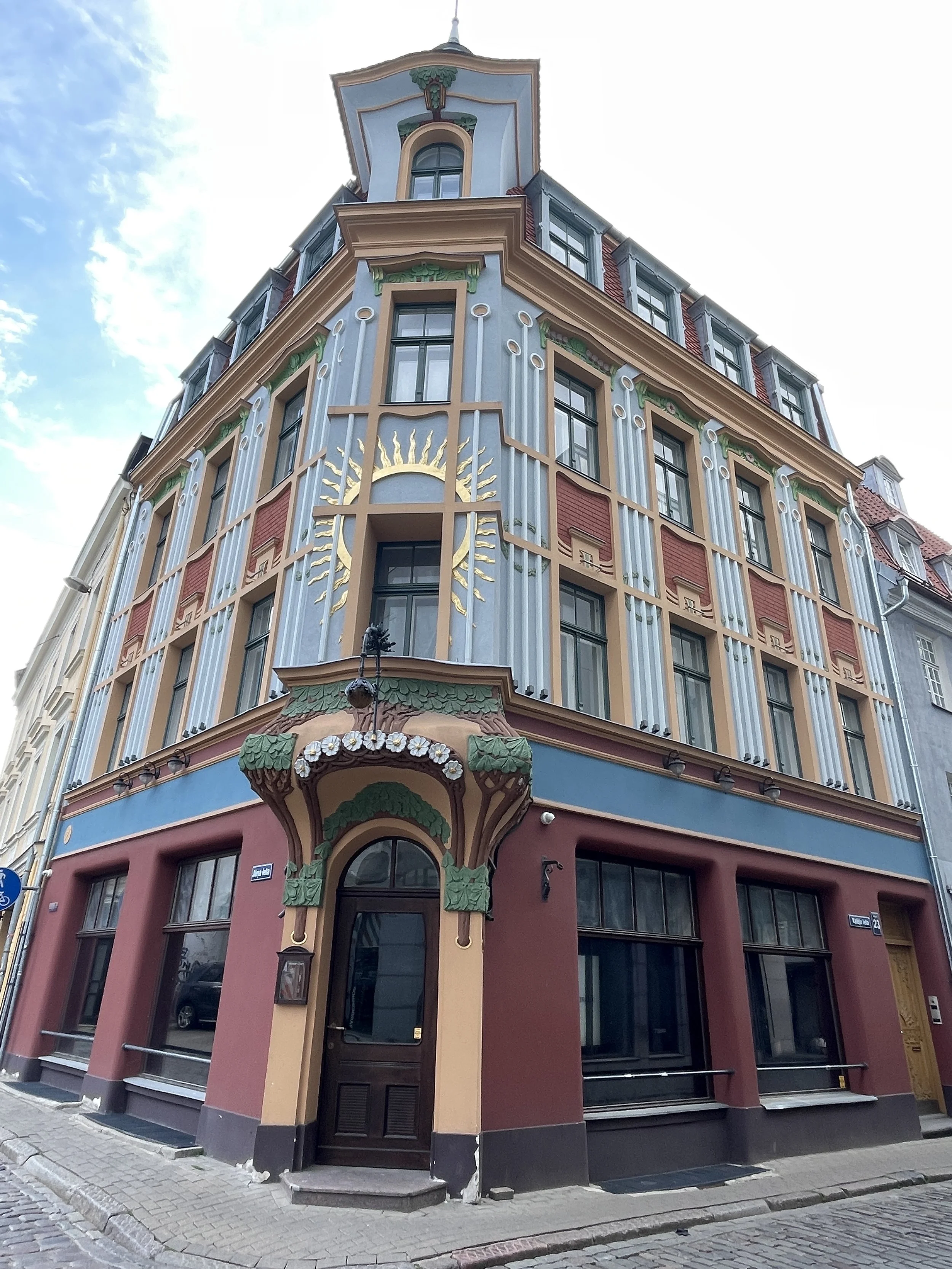“All that whipped cream”: Mikhail Eisenstein and Riga’s Jūgendstila
Mikhail Eisenstein’s son was not the biggest fan of his buildings, calling their sculptural ornaments “all that whipped cream” stuck to the outside of the building. However, that distinctive decoration defines an important part of Riga’s Art Nouveau period. It is an aesthetic that borrows from multiple architectural traditions to create a particular Riga style. Like his architecture, Eisenstein’s life was a blend of cultures and circumstances particular to the Latvian capital at the turn of the 20th century. And like its architecture, Riga was experiencing a transformation that reflected a burgeoning Latvian nationalism and independence, yet was destined to end in war and revolution.
Mikhail Eisenstein
Born in 1867 in St. Petersburg, Mikhail Eisenstein had a knack for social mobility. He married Yulia Konyetskaya, the daughter of a wealthy shipping family, bringing him both means and connections. Although Tsar Nicholas was relatively tolerant of Jews, he converted to Russian Orthodoxy to cement his pro-Romanov bona fides. After obtaining an engineering degree in Russia, he got a job in Riga’s interior ministry at a time when only Russians were allowed to manage construction. With Yulia’s money, they decorated an elegant apartment and became a fixture of Riga’s upper-class cultured society.
In addition to managing Riga’s traffic department, Eisenstein started an architectural practice. His connections to Riga’s German and Russian aristocrats, not to mention ties to the Romanov court, undoubtedly helped him find commissions. From 1901 to 1906 he designed multiple apartment complexes, averaging three buildings per year. While almost identical inside, no two façades are the same.
Stylistically, Eisenstein adopted the newly-emerging Art Nouveau, known as Jūgendstila in Riga. He likely drew inspiration from several sources. Although there is no evidence that he attended, he owned the catalogue and related publications from the 1900 Exposition Universelle in Paris as well as publications of the Vienna Secession. He saw Art Nouveau objects at the 1901 Riga crafts and industries exhibition which was a small-scale version of a World’s Fair. In his first design period, Eisenstein’s buildings are essentially neo-Classical boxes covered in a burst of sculptural ornamentation, much of it influenced by Paris and Vienna.
After 1906, his architectural designs stopped. Perhaps a 1905 uprising—a precursor to the Russian Revolution—made bourgeois excess less palatable. Or maybe his deteriorating domestic situation affected his work. In 1909 Yulia, bored with life in Riga, started an affair with a general, father of her son’s friend. She returned to St. Petersburg, taking her elegant furniture and son with her. In an act of materialism over maternalism, she later shipped him back to his father but kept the furniture. Eisenstein would design more buildings at the end of the decade, but with much more stylistic restraint.
Riga in 1900
When Eisenstein was born in 1867, Riga had been a province of the Russian empire for over 150 years. Baltic Germans had dominated its economy and aristocracy for even longer and ruled over a serfdom that wasn’t fully abolished in Latvia until the 1860s. Speaking Latvian was considered bad manners. By the time Eisenstein arrived, Riga was growing and rapidly industrializing. It had the most active port in the Russian empire. Many Latvians were moving from the country, doubling its population in the first 15 years of the 20th century. Riga grew outwards from its medieval center, but followed a grid pattern, similar to the Eixample neighborhood in Barcelona.
Like Barcelona, Prague, Ljubljana, and other European cities at the turn of the 20th century, Art Nouveau would dominate new neighborhoods and construction. Forty percent of Riga’s buildings were, and still are, in the Art Nouveau style. Why? For the same reason as those other cities: Art Nouveau was an aesthetic that broke from proscribed traditionalism and expressed an original, often nationalistic, style. In addition, the Riga Polytechnic Institute began graduating native-born architects in the 1870s. By the turn of the 20th century, a cadre of designers expressed emerging Latvian nationalism and culture through their buildings.
Jūgendstila
Riga’s Jūgendstila was marked by three sub-categories: eclectic or decorative style, vertical or perpendicular style, and National Romantic style. Despite the “new” label, these styles had foundations in earlier, often classical, architecture. The newness came mainly from decoration, architectural elements, and materials that departed from imitative revival styles.
The bourgeois bureaucrat, Mikhail Eisenstein, seems an unlikely leader of the decorative sub-style, yet he created some of Riga’s most fanciful buildings. On a symmetrical, classical frame, he applied an array of sculptural ornamentation: figures, flora, and fauna, projecting from spandrels, lintels, door frames, and cornices. It is not difficult to understand why his critics thought it excessive. But if you look more closely, you may see more than just decoration. Scholar Solveig Rush has argued that Eisenstein, while not necessarily portraying narrative, did express meaning and context through the symbols that he chose.
Detail from Alberta Iela 13, Riga, Mikhail Eisenstein, 1906
.
Perhaps reflecting the turbulent, transformational times, Eisenstein’s facades juxtaposed anxiety and serenity, chaos and rationality, alienation and interdependence. Male mascarons scream from their perches, as do Medusa sculptures. On the same building, calm female figures gaze on the street accompanied by unruffled peacocks, the symbol of heaven. He borrows Symbolist images, such as the poppy representing the “sleep of death”, and classical figures such as Diana the huntress and Atlas holding up a roof. Demonstrating his awareness of the greater Art Nouveau movement, Eisenstein’s ornament portrays metamorphosis and sensuality. Flora, fauna, and human figures intertwine. A male figure is encased in tendrils while those screaming heads have beards growing into foliage. Half-female-half-animal sphinxes ponder their riddles. Metamorphosis was a key theme of Art Nouveau artists, particularly in Brussels and Paris, yet it manifested mainly in decorative arts. Apparently, Eisenstein wanted to borrow the concept of Lalique’s dragonfly brooch and put it on a building, not a dress. Is it all a bit much? Maybe. But it’s not boring.
Dragonfly corsage, René Lalique, Paris, c. 1897-98
Photo credit: Calouste Gulbenkian Museum
By 1905 Eisenstein’s robust style was fading along with the glow of empire. Riga’s population influx meant that by 1908, nearly 45% of Riga homeowners were Latvians who were reading hundreds of newly established Latvian-language newspapers and magazines in their sitting rooms. Growing out of this cultural and economic shift, Latvian architects wanted to express their culture through their buildings, spawning the National Romantic sub-style of Art Nouveau.
In many ways the style shares the philosophy of the Arts & Crafts movement, rather than Art Nouveau. Aesthetically, architects wished to copy the country’s vernacular wooden architecture but expressed in stone and brick. They espoused the primacy of natural materials and function, sometimes leaving aspects of the construction obvious. They eschewed imitative, applied ornament, instead borrowing ethnographic motifs for decoration. Many of the buildings do not appear today as originally conceived. The Soviets stripped and scrapped much of the wrought iron decoration.
Krišjana Valdemara Iela 18, Riga, Augusts Malvess, 1910
Aleksandrs Vanags was a quintessential architect of the National Romantic movement. Born and raised on a farm east of Riga, he came to the city as a young man to study construction and architecture at the Riga Polytechnic. He began his career around 1902 as the city was growing. His buildings’ façades are relatively plain yet he uses different colored materials to create pattern. Gables, bowed windows, and varying geometric shapes echo the buildings of his rural upbringing and create visual interest and delineation.
The work of Pauls Mandelštams, the architect of our Hotel Hestia Jugend, spanned the stylistic transition of the period. Many of his buildings display the verticality characteristic of perpendicular Art Nouveau, an aesthetic that nods to the Vienna Secession and was the most prolific style of the period. The windows, bays, and gables had a strict, almost column-like, linearity, but Mandelštams used the spaces in between, along with the balconies, spandrels, and lintels, to express his strong decorative sense. Early in the decade, he uses imaginative applied ornament, but his later buildings show more restraint. At Hestia Hotel Jugend, the decoration is mainly expressed through materials, pattern, and color.
Kaleju Iela 23, Riga, Paul Mandelštams, 1903
By end of the decade, the taste for National Romanticism and Art Nouveau was fading as criticism grew. One dyspeptic writer used phrases like “a piece of senseless mishmash”, “a mess of forms, lines, and colors”, and “incomprehensible and disgusting adornments” in his criticism. Maybe he was a fan of Adolf Loos who had published his famous essay, “Ornament and Crime”, in Austria in 1908. Modernism was starting to percolate with the Futurists in Italy and the Cubists in France. Times were changing.
Denouement
Whether some form of Art Nouveau would have continued if a war hadn’t intervened is impossible to say, but the movement was gone by 1914. World events also overtook Latvia and the Eisenstein family. A poorly-prepared Russia entered World War I in 1914 and quickly suffered major losses to Germany. The conduct of the war was one of the factors leading to the Bolshevik revolution and Soviet control of Latvia. At the end of the war, Latvia would fight and gain its independence. At the end of the revolution, Eisenstein father would fight Eisenstein son.
Following the 1917 October Revolution, the Romanov loyalist Mikhail became an engineer for the White Army. His son took up arms with the Red Army. Unknowingly they faced each other at the battle of Petrograd. When the White Army was defeated, Mikhail fled with thousands of other Russians to Berlin where he lived an impoverished life and died of heart failure in 1920.
His son flourished in the Soviet system because his son was filmmaker Sergei Eisenstein. Sergei was a pioneer of montage theory, an editing technique that links individual images and symbols to create a cohesive whole, suggesting narrative and evoking emotions with little or no dialogue. The Odessa steps scene from Eisenstein’s Battleship Potemkin is one of the most famous examples of Soviet montage, portraying chaos, tragedy, and pathos through the quick-cut images. Although he disapproved of “all that whipped cream,” perhaps something in his father’s buildings influenced Sergei. Like one of Mikhail’s sculptural façades, he created a symbolic, visual assemblage that inspired emotion and conjured meaning.




